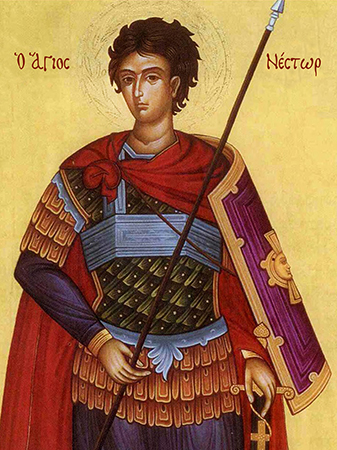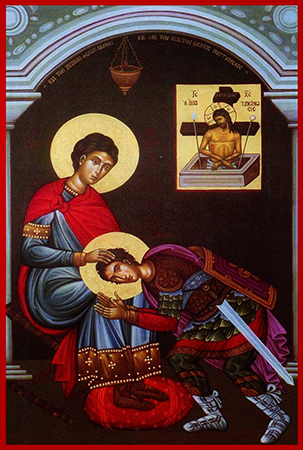By St. Nikolai Velimirovich
In the time of the suffering of St. Demetrios the Myrrhgusher, there was a young man of Thessalonica, Nestor, who learned the Christian Faith from St. Demetrios himself.
At that time Christ›s enemy, Emperor Maximian, organized various games and amusements for the people.  The emperor›s favorite in these games was a Vandal by the name of Lyaeus, a man of Goliath-like size and strength. As the emperor›s gladiator, Lyaeus challenged men every day to single combat and slew them. Thus, the bloodthirsty Lyaeus amused the bloodthirsty, idolatrous Maximian. The emperor built a special stage for Lyaeus›s battles, similar to a threshing floor on pillars. Spears, points upward, were planted beneath this platform. When Lyaeus defeated someone in wrestling, he would throw him from the platform onto the forest of spears. The emperor and his pagan subjects cheered as some poor wretch writhed in torment on the spears until he died.
The emperor›s favorite in these games was a Vandal by the name of Lyaeus, a man of Goliath-like size and strength. As the emperor›s gladiator, Lyaeus challenged men every day to single combat and slew them. Thus, the bloodthirsty Lyaeus amused the bloodthirsty, idolatrous Maximian. The emperor built a special stage for Lyaeus›s battles, similar to a threshing floor on pillars. Spears, points upward, were planted beneath this platform. When Lyaeus defeated someone in wrestling, he would throw him from the platform onto the forest of spears. The emperor and his pagan subjects cheered as some poor wretch writhed in torment on the spears until he died.
 The emperor›s favorite in these games was a Vandal by the name of Lyaeus, a man of Goliath-like size and strength. As the emperor›s gladiator, Lyaeus challenged men every day to single combat and slew them. Thus, the bloodthirsty Lyaeus amused the bloodthirsty, idolatrous Maximian. The emperor built a special stage for Lyaeus›s battles, similar to a threshing floor on pillars. Spears, points upward, were planted beneath this platform. When Lyaeus defeated someone in wrestling, he would throw him from the platform onto the forest of spears. The emperor and his pagan subjects cheered as some poor wretch writhed in torment on the spears until he died.
The emperor›s favorite in these games was a Vandal by the name of Lyaeus, a man of Goliath-like size and strength. As the emperor›s gladiator, Lyaeus challenged men every day to single combat and slew them. Thus, the bloodthirsty Lyaeus amused the bloodthirsty, idolatrous Maximian. The emperor built a special stage for Lyaeus›s battles, similar to a threshing floor on pillars. Spears, points upward, were planted beneath this platform. When Lyaeus defeated someone in wrestling, he would throw him from the platform onto the forest of spears. The emperor and his pagan subjects cheered as some poor wretch writhed in torment on the spears until he died.
Among Lyaeus›s innocent victims were many Christians: when no one volunteered to duel with Lyaeus, by the emperor›s orders Christians were arrested and forced to duel with him. Seeing this horrifying amusement of the pagan world, Nestor›s heart was torn with pain, and he decided to come forward for a duel with the gigantic Lyaeus. But first, he went to prison to see St. Demetrios and sought a blessing from him to do this. St. Demetrios blessed him, signed him with the sign of the Cross on the forehead and on the chest and prophesied to him: «You will defeat Lyaeus, but you will suffer for Christ.» Thus, young Nestor went to duel with Lyaeus.
Maximian was present with a multitude  of people; everyone felt pity for the young Nestor, who would surely die, and tried to dissuade him from dueling with Lyaeus. Nestor crossed himself and said: «O God of Demetrios, help me!» and with God›s help, he overcame Lyaeus, knocked him down, and threw him onto the sharp spears, where the heavy giant soon found death. Then all the people cried out: «Great is the God of Demetrios!» But the emperor, shamed before the people and sorrowing for his favorite Lyaeus, was greatly angered at Nestor and Demetrios, and commanded that Nestor be beheaded and Demetrios run through with lances. Thus, the Christian hero Nestor ended his earthly life and took up his habitation in the Kingdom of his Lord in the year 306.
of people; everyone felt pity for the young Nestor, who would surely die, and tried to dissuade him from dueling with Lyaeus. Nestor crossed himself and said: «O God of Demetrios, help me!» and with God›s help, he overcame Lyaeus, knocked him down, and threw him onto the sharp spears, where the heavy giant soon found death. Then all the people cried out: «Great is the God of Demetrios!» But the emperor, shamed before the people and sorrowing for his favorite Lyaeus, was greatly angered at Nestor and Demetrios, and commanded that Nestor be beheaded and Demetrios run through with lances. Thus, the Christian hero Nestor ended his earthly life and took up his habitation in the Kingdom of his Lord in the year 306.
HYMN OF PRAISE: The Holy Martyr Nestor
St. Nestor was outraged at evil
And was zealous for the Christian Faith.
The young disciple of St. Demetrios
Seemed young and weak against the terrible Lyaeus,
But he traced the sign of the Cross on himself
And impaled the powerful Lyaeus on a spear.
He had been given power from above,
Like David against Goliath.
«You will conquer, but you will be tortured,
And will lay down your life for Christ.»
Thus Demetrios prophesied to him,
And as he said, so it came to pass.
Nestor jubilantly went to torture,
And wonderfully magnified the wondrous Christ
With sweet words and sweet hymns,
And fervent prayers for the Church.
Great in spirit, small in years,
He did not grieve over his young life;
His blood strengthened the Church,
And Nestor was eternally glorified.
Apolytikion in the Fourth Tone
Thy Martyr, O Lord, in his courageous contest for Thee received the prize of the crowns of incorruption and life from Thee, our immortal God. For since he possessed Thy strength, he cast down the tyrants and wholly destroyed the demons› strengthless presumption. O Christ God, by his prayers, save our souls, since Thou art merciful.
Kontakion in the Second Tone
Well didst thou contest; hence, thou hast now inherited immortal renown, wise Nestor, and thou art become Christ the Master›s excellent soldier by the holy and fervent prayers of the Martyr Demetrios. Thus, with him, cease not to pray for all of us.
thanks to:
